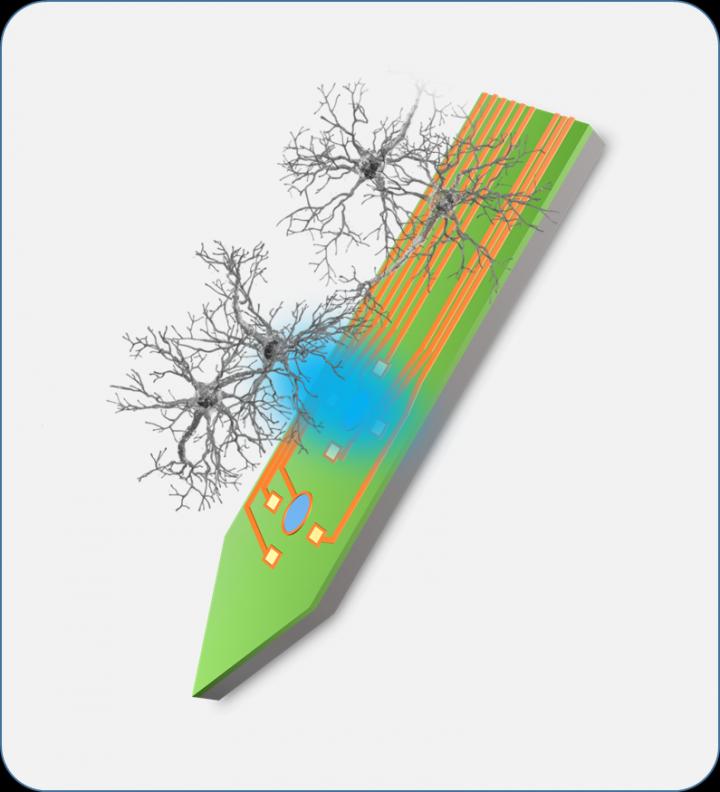Optogenetic control and recording technology aimed towards elucidation of brain function

Credit: COPYRIGHT (C) TOYOHASHI UNIVERSITY OF TECHNOLOGY. ALL RIGHTS RESERVED.
Overview:
Associate Professor Hiroto Sekiguchi and Ph.D. candidate Hiroki Yasunaga in the Department of Electrical and Electronic Information Engineering at Toyohashi University of Technology have developed a MicroLED neural probe for neuroscience. This MicroLED tool can optogenetically control and observe neural activity in the brain. Neural activity was successfully recorded using the neural probe, and sufficient light output was obtained from the MicroLED to activate neural activity. The developed MicroLED tool will contribute to the development of neuroscience research-purposed optogenetic technology.
Details:
A research team in the Department of Electrical and Electronic Information Engineering at Toyohashi University of Technology has developed a MicroLED neural probe for neuroscience. This MicroLED tool can optogenetically control and observe neural activity in the brain. The neural activity was successfully recorded using the neural probe, and a light output that is sufficient to activate neural activity is obtained from the MicroLED. This probe will contribute to the development of neuroscience research-purposed optogenetic technology. The results of their research will be published in Japanese Journal of Applied Physics on December 16, 2020.
Advanced information processes are associated with higher brain functions and are the products of complex interactions between interconnected neurons. Optogenetic technology uses light to precisely target specific cells for manipulation without affecting other cells in the brain, which contributes to elucidating how neural activity and animal behaviors are linked. Although an optical fiber has been used as a photodelivery system, there are some issues with high invasion of the brain tissue and complex spatial control.
In the field of engineering, microLEDs, which are 1/10 or 1/100 of the performance of the conventional LED, have been attracting attention towards the realization of the high-brightness, highly efficient, and high resolution display. In this study, we have fabricated a new device that applies this small LED to brain science. The developed epoch-making neural probe tool can solve tasks in conventional neuroscience tools and can control and record the functions of different nerves in a complex area with a high spatiotemporal resolution.
The leader of the research team, Associate Professor Hiroto Sekiguchi, said, “We have been developing LED materials and MicroLED fabrication technology for more than 10 years, and LEDS are being industrialized. I have to find a new field to utilize LED technology. At one point, I met a pharmacy researcher in an encounter unrelated to research, and talked about research in a casual conversation. Half a year later, I received a consultation about this research, which led to the results of this research. I think that the simple and easy-to-understand explanations and the active interest in discussing themes in different fields has led to present research in the area of fusion of pharmacy and engineering.”
The research team believes that the developed MicroLED neural probe would be useful as a tool for in vivo optogenetics research. If the mechanism of the brain is elucidated, the findings can be utilized in various fields, such as the establishment of treatment for cancer, psychiatric disorders, and epilepsy, application to brain-machine interface, and development of new algorithms based on brain function.
###
Reference:
Hiroki Yasunaga, Toshihiro Takagi, Diasuke Shinko, Yusei Nakayama, Yuichi Takeuchi, Atsushi Nishikawa, Alexander Loesing, Mashiro Ohsawa, and Hiroto Sekiguchi (2021). Development of a neural probe integrated with high-efficiency MicroLEDs for in vivo application, 10.35848/1347-4065/abcffa/meta.
This work was partially supported by the Precursory Research for Embryonic Science and Technology Agency (JPMJPR1885), Research Foundation for OptoScience and Technology, and the Nitto Foundation.
Media Contact
Yuko Ito
[email protected]
Related Journal Article
http://dx.




